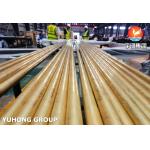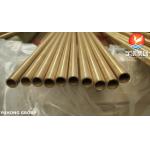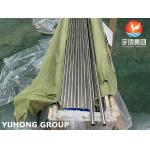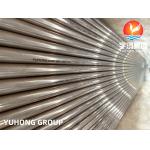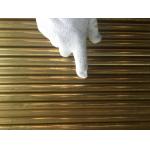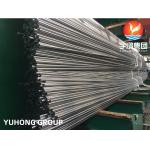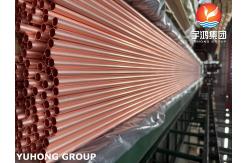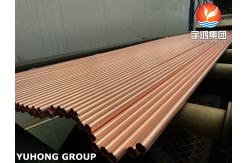ASTM B111 / ASME SB111 C12200 Copper Tube for Condenser and Heat
Exchanger Application
ASTM B111 is a standard developed by the American Society for Testing and
Materials, which specifically specifies technical requirements for
the chemical composition, mechanical properties, dimensional
tolerances, non-destructive testing, hydrostatic testing, and other
aspects of seamless copper and copper alloy tubes used in the
manufacture of condensers, evaporators, and heat exchangers. C12200 is a specific copper alloy grade specified under this standard,
belonging to phosphorus deoxidized copper, which is a low residual
phosphorus oxygen free copper.
Why is ASTM B111 C12200 Copper Tube widely used in the Heat
Exchange Industry? - Excellent thermal conductivity: Copper has excellent thermal conductivity, second only to silver,
while C12200 copper tube has a very high thermal conductivity
coefficient (about 391 W/m · K), which is the core advantage of
making it a heat exchange tube such as condenser and heat exchange
tube, capable of efficiently transferring heat.
- Good corrosion resistance: C12200 copper tube not only has good corrosion resistance and can
maintain excellent performance in fresh water and steam condensate
water, but also has good resistance to zinc removal corrosion and
stress corrosion cracking, both of which are due to phosphorus
element. Resistance to zinc removal corrosion is a significant
advantage of phosphorus containing deoxidized copper such as C12200
compared to oxygen free copper such as C10200/C10100. In
environments containing dissolved oxygen and carbon dioxide in
brackish water, seawater, or certain water treatment chemicals,
ordinary copper nickel tubes are prone to zinc removal due to the
selective dissolution of zinc, leaving behind porous and fragile
copper structures. The phosphorus in C12200 can effectively prevent
this corrosion form from occurring, while also improving the stress
corrosion cracking resistance of copper pipes in specific media
environments such as ammonia.
- Good welding and brazing performance: The presence of phosphorus improves the welding and brazing
performance of copper tubes, making it easier to perform tube plate
connections during the manufacturing of heat exchangers.
Good mechanical and processing properties: C12200 copper tubes have sufficient strength, hardness, and
ductility, making them easy to bend, expand, and form to meet
installation requirements. Good ductility and toughness: C12200 copper tubes can maintain good toughness even at lower
temperatures. Conductivity: Due to the presence of phosphorus impurities, although the
conductivity of C12200 copper tube is slightly lower than that of
oxygen free copper such as C10200/C10100, its conductivity is still
very high, about 85-90% IACS, which is sufficient to meet the needs
of the vast majority of heat exchange applications.
ASTM B111 C12200 Copper Tube Chemical Composition | UNS NO. | ASTM B111 C12200 CHEMICAL COMPOSITION % |
|---|
| CU | Al | NI | ZI | P |
|---|
| C12200 | 99.9 | --- | --- | --- | 0.015-0.040 |
What is the difference between ASTM B111 C12200 Copper Tube and
other Copper Tubes? - Vs C11000 (ETP Copper electrolytic tough copper): C11000 has a higher oxygen content (0.02% -0.04%), which may cause
hydrogen embrittlement in reducing atmospheres such as hydrogen,
and its resistance to zinc removal corrosion is not as good as
C12200. C12200, due to deoxidation treatment, avoids hydrogen
embrittlement problems and has better resistance to zinc removal,
making it a better choice for condenser tubes.
- Vs C10200/C10100 (Oxygen Free Copper): Oxygen free copper has the highest electrical and thermal
conductivity, close to 100% IACS, and good resistance to hydrogen
embrittlement, but its resistance to zinc removal corrosion is not
as good as C12200. C10200/C10100 oxygen free copper is usually more
expensive and is commonly used in situations where high
conductivity is required for conductors or in environments that are
extremely sensitive to hydrogen embrittlement.
- VS copper-nickel alloy tubes (such as naval brass C44300, C68700
aluminum brass, CuNi 70/30, CuNi 90/10): These alloy copper tubes have better corrosion resistance in
seawater or more harsh environments, especially in terms of erosion
corrosion resistance and seawater corrosion resistance, but lower
thermal conductivity than C12200 and higher production costs.
C12200 is more cost-effective in freshwater, brackish water, or
relatively mild seawater environments.
What industries are ASTM B111 C12200 Copper Tubes mainly used in? Power plant condenser: This is the largest and most classic
application of ASTM B111 C12200 copper tubes, mainly used to
condense and return the exhaust steam from the turbine. Ship condensers and heat exchangers: ASTM B111 C12200 copper tubes
can be used for condensation and various cooling systems in ship
power plants. Heat exchangers in petrochemical, chemical, and industrial
processes: ASTM B111 C12200 can be used for cooling process fluids,
heating media, etc. Evaporators and condensers in HVAC systems, especially in chillers
and large systems. Refrigeration equipment: such as heat exchange components for large
cold storage and industrial refrigeration machines. Other heat exchange applications that require high thermal
conductivity, corrosion resistance, and good formability.
Summary:
ASTM B111 C12200 (DHP phosphorus deoxidized copper) seamless copper
tube is cost-effective and has excellent thermal conductivity, high
purity and biological inertness, excellent ductility and
formability, and no risk of hydrogen disease, making it widely used
in refrigeration systems, drinking water systems, low-pressure
heating systems, and general industrial heat exchangers that handle
non-corrosive media.
However, ASTM B111 C12200 has very poor erosion corrosion
resistance and dezincification corrosion resistance, and has low
mechanical strength. Therefore, when choosing to use ASTM B111
C12200 seamless copper tubes, it is necessary to strictly limit its
use environment, such as clean water, non-oxidizing fluids, no
solid particles, low flow rate, no chloride ions, no ammonia, etc.
Once these limits are exceeded, or chloride ions or high flow rates
appear, aluminum brass (C68700), naval brass (C44300) or
copper-nickel alloy (C70600, C71500) must be used.
|
